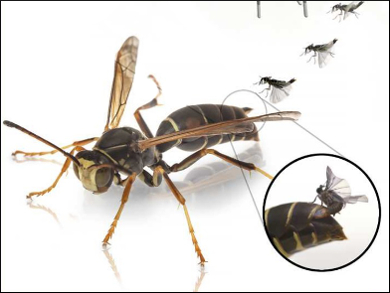As an endoparasitoid insect, Xenos peckii develop inside paper wasps. The X. peckii male emerges from his host wasp as a free-living adult, whereas the female remains permanently embedded within the wasp abdomen. She emits a long-range, male-attractant sex pheromone, which was recently identified as (7E,11E)-3,5,9,11-tetramethyl-7,11-tridecadienal.
Robert Britton, Gerhard Gries, and colleagues, Simon Fraser University, Burnaby, Canada, synthesized three candidate stereostructures for this pheromone, they used a synthetic strategy that relies on an sp3-sp2 Suzuki-Miyaura coupling to construct the central alkene function in the molecule. Comparison of the 1H NMR spectra of these synthetic candidates with that of the natural sex pheromone indicated a relative configuration of (3R*,5S*,9R*). Chiral gas chromatographic (GC) analyses supported an assignment of (3R,5S,9R) for the natural product.
In a 16-replicate field experiment, traps baited with the synthetic (3R,5S,9R)-enantiomer alone or in combination with the (3S,5R,9S)-enantiomer captured 23 and 18 X. peckii males, respectively. Traps baited with the synthetic (3S,5R,9S)-enantiomer or a solvent control captured no males. These data, in combination with spectroscopic and chiral GC data, unambiguously demonstrate that (3R,5S,9R,7E,11E)-3,5,9,11-tetramethyl-7,11-tridecadienal is the X. peckii sex pheromone.
- Total Synthesis, Stereochemical Assignment, and Field-Testing of the Sex Pheromone of the Strepsipteran Xenos peckii,
Huimin Zhai, Michael Hrabar, Regine Gries, Gerhard Gries, Robert Britton,
Chem. Eur. J. 2016.
DOI: 10.1002/chem.201505097




